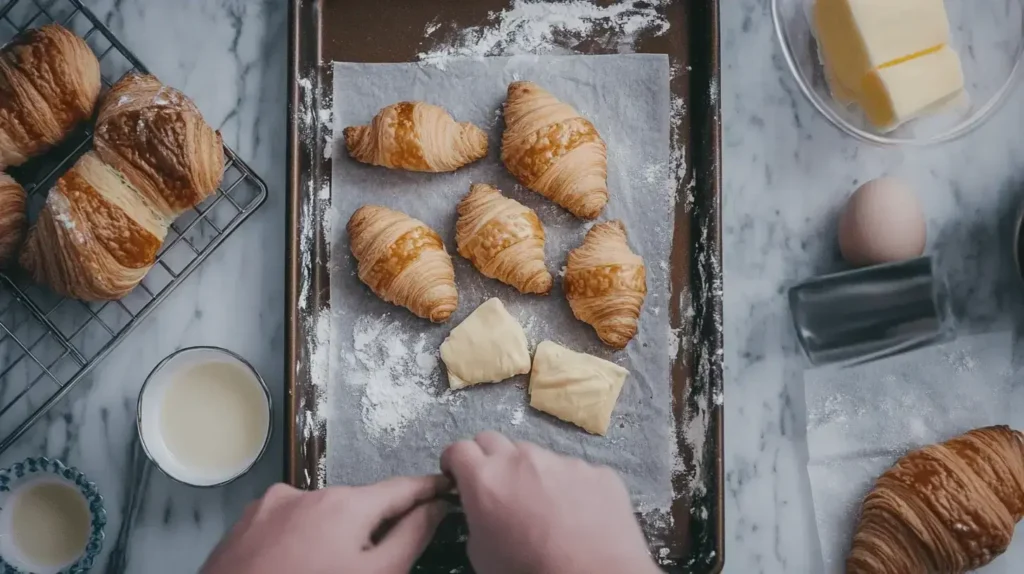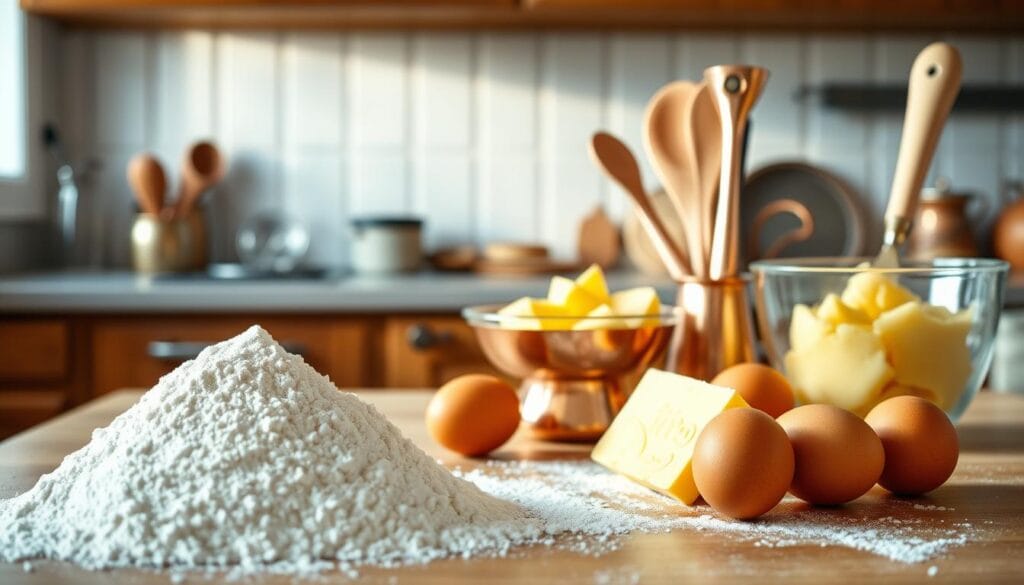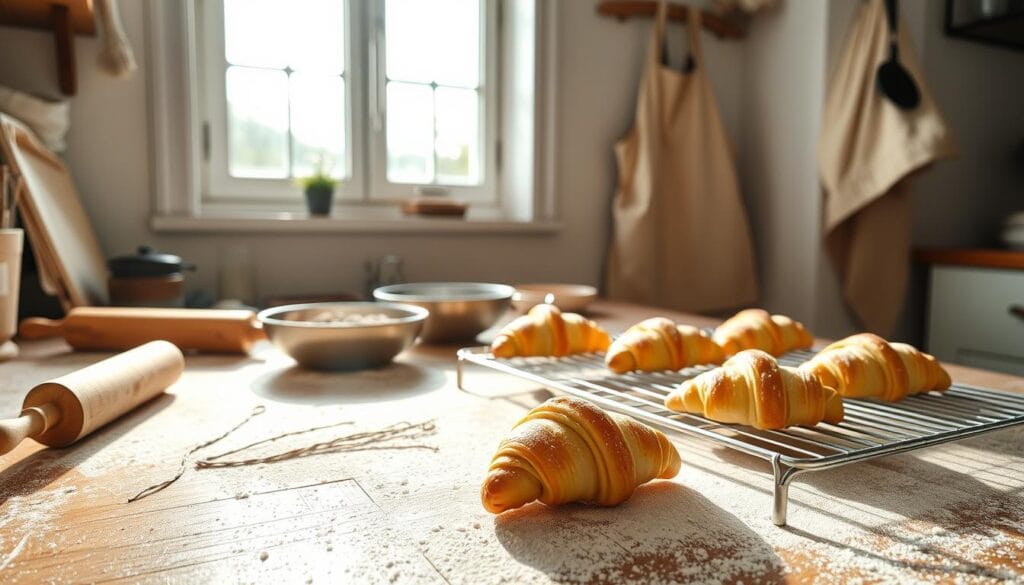Imagine waking up to the warm, buttery aroma of freshly baked Swiss pastry. It fills your kitchen, making your morning special. The gipfeli recipe brings Swiss culinary tradition to your home.
This Swiss pastry is a masterpiece of baking. It’s a golden-brown crescent that’s both crispy and soft inside. It’s a great choice if you want something different from croissants.
Making gipfeli is all about precision and passion. You’ll need flour, warm milk, and cold butter. These ingredients connect you to Swiss baking traditions. It’s perfect for both experienced bakers and those new to cooking.
Ready to make authentic gipfeli in your kitchen? This guide will show you how. You’ll learn about lamination and how to get that perfect golden crust. It’s a journey into making these Swiss treats.
Understanding Swiss Gipfeli: A Traditional Delight
Swiss pastry fans love the gipfeli for its rich history and taste. It’s a symbol of traditional baking in Switzerland. This crescent-shaped treat has brought Swiss food lovers together for generations.

Origins of Swiss Gipfeli
The gipfeli started in the early 19th century, influenced by Austrian Kipferl pastry. Swiss bakers made it their own, turning it into a beloved Swiss treat.
- Originated in early 19th century Switzerland
- Inspired by Austrian Kipferl pastry
- Evolved into a distinct Swiss specialty
How Gipfeli Differs from Croissants
Gipfeli and croissants may look similar, but they’re not the same. Swiss bakers use a special method and ingredients. This makes gipfeli unique in taste and texture.
| Characteristic | Gipfeli | Croissant |
|---|---|---|
| Butter Content | 82% butter fat | Higher butter percentage |
| Shape | Slightly less curved | More pronounced crescent |
| Texture | Lighter, less dense | More layered, richer |
Cultural Significance in Switzerland
Gipfeli is more than a pastry; it’s a cultural icon. It’s enjoyed at breakfast or as a snack. This tradition brings families and communities together.
“A gipfeli is not just food, it’s a piece of Swiss heritage you can taste.” – Swiss Culinary Historian
Essential Ingredients for Perfect Gipfeli
To make a real gipfeli, start with top-notch ingredients. They turn simple dough into a stunning butter brioche. Learning to make Swiss pastry means knowing the key ingredients that make it special.

The heart of a great gipfeli is in choosing the right ingredients. Each one is vital for the pastry’s flaky texture and deep flavor.
Key Ingredients for Authentic Gipfeli
- All-Purpose Flour: 500 grams (about 4 cups) is the base
- Active Dry Yeast: 2 teaspoons for light, airy layers
- Cold Unsalted Butter: 250 grams for flaky layers
- Warm Milk: 250 ml to activate yeast and mix ingredients
- Sugar: 50 grams for a hint of sweetness
- Salt: 1 teaspoon to boost flavor
“The secret to a perfect gipfeli is not just in the recipe, but in the quality of ingredients and precision of technique.” – Swiss Baking Tradition
Temperature and ingredient quality are key in your gipfeli recipe. Cold butter is essential for those delicate, layered pastries. Each ingredient affects the final taste and texture of your Swiss pastry.
Pro Tip for Ingredient Selection
- Choose fresh, high-quality ingredients
- Make sure butter is very cold
- Measure ingredients carefully
- Pick unbleached, high-protein flour
By focusing on the right ingredients, your gipfeli will go from good to great. It will bring a taste of Swiss baking tradition to your kitchen.
Master the Gipfeli Recipe: Step-by-Step Guide
Making the perfect gipfeli recipe needs precision and traditional baking skills. This guide will help you make authentic Swiss pastries, just like those in Alpine bakeries.

Making delicious gipfeli involves several key steps. These steps turn simple ingredients into flaky, tasty pastries. The process requires patience and careful attention.
Preparing the Basic Dough
Begin your baking journey by choosing top-quality ingredients. You’ll need:
- Zopfmehl or all-purpose flour
- Active dry yeast
- Unsalted Swiss butter
- Salt
- Warm milk
Knead the dough for 8-10 minutes until it’s smooth and elastic. This step is crucial for creating the right texture in gipfeli.
The Lamination Process
Lamination is key to getting those flaky layers in your gipfeli. It involves folding cold butter into the dough several times.
“Proper lamination transforms simple dough into a masterpiece of Swiss baking.” – Swiss Baking Tradition
Fold the dough three times, chilling it between folds. This ensures the dough stays flaky and layered, making gipfeli special.
Shaping and Baking Techniques
| Step | Temperature | Duration |
|---|---|---|
| Proofing | Warm area | 45-60 minutes |
| Baking | 375°F (190°C) | 18-22 minutes |
Shape the dough into crescent shapes. Brush with egg wash for a golden finish. Bake until they’re golden brown, with a crisp outside and soft inside.
Pro tip: Use cold butter and chill the dough between folds to enhance the flakiness of your traditional baking masterpiece.
The Art of Butter Layering in Gipfeli
Learn the secret to making the most delicious butter brioche-like gipfeli. The art of butter layering is key. Traditional baking shows that lamination makes the pastry layers flaky and soft.
The lamination process turns simple ingredients into a special treat. You aim to make thin, even layers of butter and dough. These layers will make your pastry light and airy.
“Precision is the soul of lamination in traditional baking” – Professional Pastry Chefs
Lamination Layer Breakdown
- 3-fold method results in 9 total layers
- Dough layers always equal twice the butter layers plus one
- French method creates 1 butter layer
- English method develops 2 butter layers
Butter temperature is very important. It should be cold but soft, around 55-60°F. This helps it mix smoothly with the dough without breaking it.
Pro Techniques for Perfect Layers
- Keep butter at consistent temperature
- Roll dough evenly
- Use gentle, consistent pressure
- Chill between folding stages
Tip: Patience is your greatest ally in creating those signature flaky gipfeli layers!
Professional Tips for Flaky Texture: gipfeli recipe
Making the perfect gipfeli recipe is all about mastering traditional baking techniques. Achieving flaky layers is an art that needs precision and patience.
Maintaining Precise Temperature Control: gipfeli recipe
Success in baking depends on controlling the temperature. Cold ingredients are key for those delicate, flaky layers in your gipfeli. Here are some professional tips:
- Refrigerate butter until it’s firm but pliable
- Work in a cool kitchen environment
- Use a marble surface for rolling dough
- Chill dough between folding stages
Mastering Dough Handling for gipfeli recipe
Gentle handling is crucial for a light, airy gipfeli. Your technique should be both delicate and confident:
- Roll dough gently to prevent gluten development
- Use minimal pressure when folding
- Maintain consistent thickness during rolling
- Avoid overworking the dough
Timing and Patience Matter for gipfeli recipe
Traditional baking is not a race. Your gipfeli recipe needs respect for each step. Rushing will ruin your pastry’s texture and flavor.
“Perfection takes time, especially in baking.” – Professional Baker’s Wisdom
The lamination process involves 4-6 precise folds, with 30-minute chilling periods between each. This ensures those flaky, buttery layers that make gipfeli so irresistible.
Sweet and Savory Filling Options for gipfeli recipe
Make your breakfast rolls special with tasty gipfeli fillings. These options turn a simple Swiss pastry into a treat. Choose from sweet or savory to spark your cooking ideas.
Sweet Filling Delights for gipfeli recipe
Try these sweet fillings to satisfy your cravings:
- Dark chocolate chips
- Raspberry jam
- Nutella with sliced bananas
- Almond paste
- Caramel sauce
Savory Flavor Combinations gipfeli recipe
For a bold taste, try these savory Swiss pastry options:
- Swiss cheese blend
- Ham and cheddar
- Herb-infused cream cheese
- Roasted vegetable medley
- Dijon mustard with fresh herbs
| Filling Type | Recommended Quantity | Flavor Profile |
|---|---|---|
| Dark Chocolate | 4 oz | Rich and decadent |
| Ham and Cheese | 4 oz each | Savory and satisfying |
| Cream Cheese | 4 oz | Creamy and versatile |
Pro tip: When adding fillings, ensure you don’t overstuff your gipfeli to maintain its delicate texture.
Try these fillings to make breakfast rolls that wow everyone. The secret is finding the right mix of flavors and being creative with your Swiss pastry.
Perfecting the Golden-Brown Crust for gipfeli recipe
Making a perfect golden-brown crust is key in traditional baking. It’s especially important for a tasty gipfeli recipe. The crust’s look shows off your skill and care, turning simple ingredients into a work of art.
Egg Wash Magic gipfeli recipe
The secret to a stunning gipfeli is its golden-brown look. An egg wash helps you get that bakery-perfect finish. Here’s how to make the perfect glaze:
- Use one whole egg or egg yolk
- Add a tablespoon of water or milk
- Whisk until completely blended
- Brush gently over the gipfeli surface
Mastering Baking Temperatures gipfeli recipe
Temperature control is vital in baking. For your gipfeli, follow these exact steps:
| Oven Setting | Temperature | Baking Time |
|---|---|---|
| Preheat | 400°F (200°C) | Prepare 15 minutes in advance |
| Baking | 375°F (190°C) | 18-22 minutes |
“The difference between good and great baking is often just a few degrees.” – Professional Baker’s Wisdom
Pro tip: Every oven is different. Use an oven thermometer for accurate temperature. Also, rotate your baking sheet halfway for even browning. Your gipfeli will have a glossy, golden crust that will wow everyone.
Storage and Reheating Guidelines for gipfeli recipe
Keeping your freshly baked gipfeli delicious requires careful storage and reheating. These breakfast rolls need special care to keep their flaky texture and taste.
- Store at room temperature in a paper bag
- Keep away from direct sunlight
- Consume within 12 hours for optimal freshness
Freezing is great for long-term storage. Wrap each gipfeli in aluminum foil to avoid freezer burn.
| Storage Method | Duration | Recommended Approach |
|---|---|---|
| Room Temperature | Up to 12 hours | Paper bag, away from heat |
| Refrigerator | Up to 3 days | Sealed container |
| Freezer | Up to 1 week | Individually wrapped |
Reheating your swiss pastry needs care. Always use an oven for the best results. Preheat to 160 degrees Celsius and warm for 5-6 minutes to restore the crispy, flaky texture.
“The secret to perfect gipfeli is in the careful storage and gentle reheating.” – Swiss Baking Tradition
Avoid microwaving your breakfast rolls, as it can make them soggy. If you’re in a hurry, wrap them in aluminum foil and use the oven for quick, crisp results.
Pairing Suggestions for Your Gipfeli recipe
Swiss pastry fans know that gipfeli are best with the right pairings. Your morning can go from good to great with the right choices.
Breakfast Flavor Companions
Try these tasty pairings with your gipfeli:
- Homemade fruit preserves
- Butter from local dairy farms
- Artisanal honey
- Cream cheese spreads
- Soft scrambled eggs
Coffee and Beverage Pairings for gipfeli recipe
The right drink can make your gipfeli even better. Specialty coffee brings out the best in gipfeli.
| Coffee Type | Flavor Profile | Gipfeli Pairing |
|---|---|---|
| Brazilian Espresso | Nutty, Chocolatey | Plain Butter Gipfeli |
| Ethiopian Light Roast | Citrus, Floral | Jam-Filled Gipfeli |
| Colombian Filter Coffee | Smooth, Mild | Savory Cheese Gipfeli |
“A perfect gipfeli is not just about the pastry, but the entire sensory experience it creates.”
Make your breakfast rolls a gourmet treat with the right pairings. Whether you like sweet or savory, there’s a perfect match for you.
Troubleshooting Common Baking Issues for gipfeli recipe
Mastering the art of baking gipfeli can be challenging for home bakers. It often takes 3 to 4 tries to get it right. Knowing how to fix common problems will help you make perfect, flaky pastries every time.
Top Gipfeli Baking Challenges
- Butter Leakage: Happens when dough is too warm or not proofed enough
- Uneven Browning: Caused by uneven oven heat
- Flat Pastries: Results from not proofing enough or wrong yeast use
Room temperature is key for baking success. Keep your area cooler than 68°F to stop butter from soaking into the dough. Experts say using butter with 82% fat helps create layers without tearing.
“Patience and precision are the secret ingredients in creating perfect gipfeli.” – Swiss Baking Master
Proofing and Temperature Tips
- Keep proofing temperature between 76°F and 79°F
- Let dough grow visibly before baking
- Use flour with 11-12% protein content
By mastering these techniques, you’ll turn your gipfeli recipe into professional-quality pastries. Remember, practice, attention to detail, and consistent technique are the keys to baking success.
Health Benefits and Nutritional Information for gipfeli recipe
Exploring the nutritional side of butter brioche-inspired gipfeli shows a balance. These Swiss breakfast rolls are not super healthy but still have some good points for those who eat mindfully.
A single gipfeli has about 200 calories, which is a fair amount for breakfast. It has a mix of nutrients:
- Protein from milk and eggs helps muscles
- Carbs give quick energy
- Fats from butter help you feel full
Making gipfeli at home has big benefits. You can pick the ingredients, avoiding preservatives and choosing natural ones.
“Quality ingredients turn a simple pastry into a nutritious morning treat” – Swiss Baking Tradition
If you’re watching your diet, here are some tips:
- Try whole wheat flour for more fiber
- Lower the sugar
- Play with how much you eat
Enjoy gipfeli as a special treat now and then. Knowing what’s in them helps you make better food choices.
Conclusion
Learning to make gipfeli is a journey that requires dedication. But the end result is well worth it. You’ll see how simple ingredients can become something truly special. With time and effort, you’ll be able to make these flaky, buttery pastries just like the pros.
The art of gipfeli making is more than just a recipe. It’s about finding the right mix of ingredients and techniques. By mastering each step, from making the dough to baking, you’ll create pastries that are as golden as they are delicious. You can also try different flavors, making each batch a new adventure.
Getting better at making gipfeli takes practice. Don’t get discouraged if it doesn’t turn out right at first. Every try teaches you something new. Share your creations and enjoy the pride of bringing a bit of Swiss tradition into your home.
FAQ
Q: What is the difference between gipfeli and croissants?
A: Gipfeli are Swiss pastries with a firmer texture than French croissants. They use a different dough technique. This makes them more compact and less airy than croissants.
Q: How difficult is it to make gipfeli at home?
A: Making gipfeli is challenging, especially the lamination process. But with practice, you can make authentic Swiss gipfeli. The key is to keep the butter cold and master the folding.
Q: Can I add fillings to my gipfeli?
A: Yes! You can fill gipfeli with sweet or savory options. Traditional fillings include chocolate chips and Swiss cheese. Try modern fillings like herb-infused cream cheese too.
Q: How long do gipfeli stay fresh?
A: Enjoy gipfeli within 1-2 days for the best taste. Store them in an airtight container at room temperature. Freeze them for longer storage and reheat in an oven.
Q: What’s the most important technique in making gipfeli?
A: The lamination process is key. It involves folding cold butter into the dough to create flaky layers. This is what makes gipfeli so special.
Q: Are gipfeli nutritionally healthy?
A: Gipfeli are treats, not health foods. They’re high in calories and fat from butter. But they also have some nutritional value from milk and eggs. Enjoy them in moderation.
Q: Can I make gipfeli ahead of time?
A: Yes, you can prepare the dough ahead and refrigerate it. The laminated dough can last up to 2 days in the fridge. Freeze unbaked gipfeli for later use.
Q: What’s the best way to serve gipfeli?
A: Serve gipfeli for breakfast. They go well with Swiss coffee, jam, or honey. For a savory option, try them with cheese or cured meats. They’re also great for brunch.

